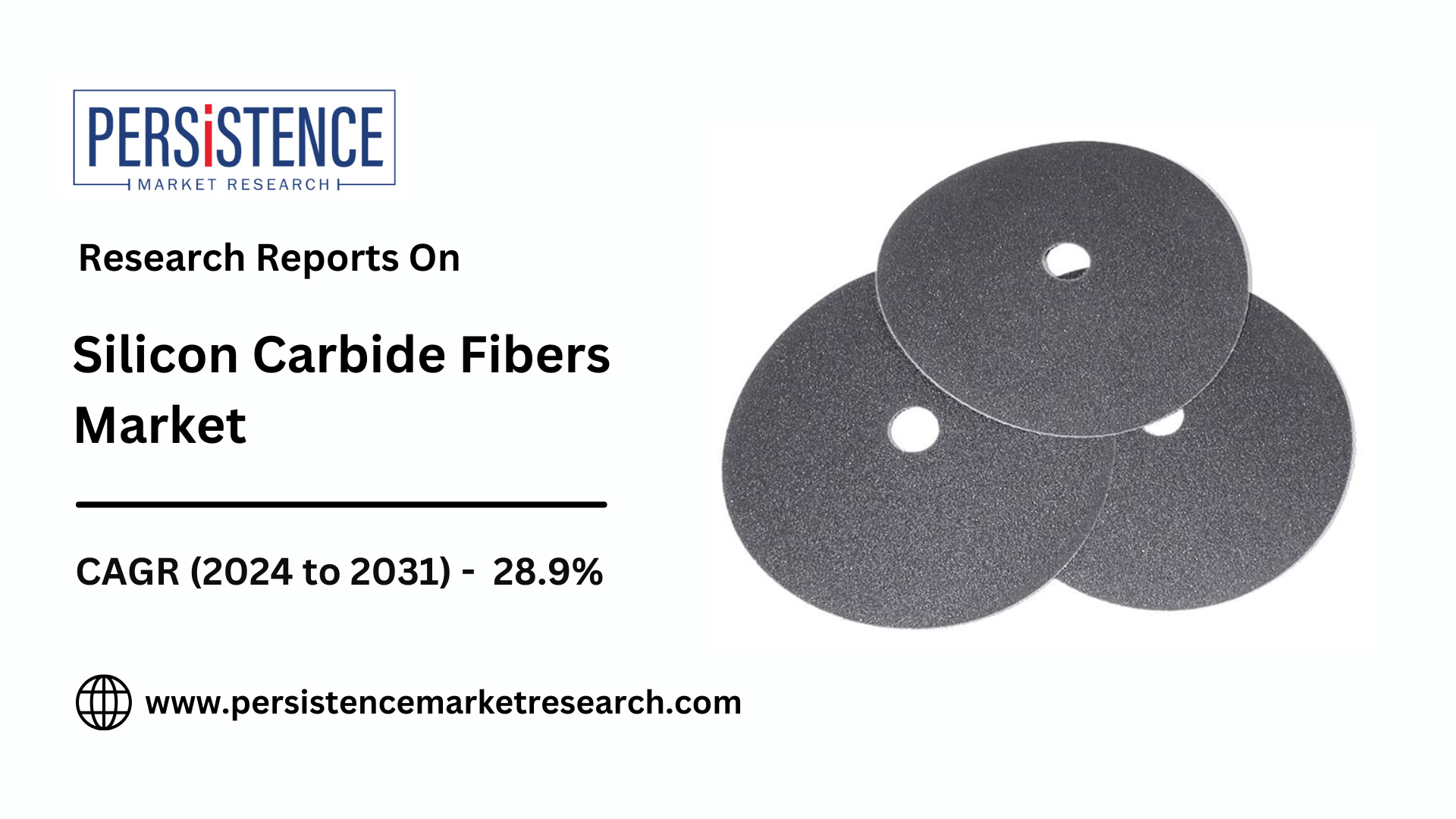 Local SEO Boost – Put Your Business on the Local Map!
Local SEO Boost – Put Your Business on the Local Map!
North America Leads in Silicon Carbide Fibers Market Growth
Written by Pooja » Updated on: June 17th, 2025

The Silicon Carbide Fibers Market is expected to grow significantly from US$0.867 billion in 2024 to US$5.1 billion by 2031, with a robust CAGR of 28.9%. This growth is driven by the increasing demand for energy-efficient solutions, particularly in the aerospace, electric vehicles, and renewable energy sectors. North America is a key contributor, with advancements in SiC fiber technology and industrial applications propelling its market dominance. Europe's industrialization is fueling SiC demand, while the aerospace sector leads market adoption due to the fibers' heat resistance and lightweight properties. Continuous fibers, particularly in high-performance applications, are driving market expansion, making silicon carbide fibers a vital material in advanced engineering fields.
Silicon carbide (SiC) fibers, recognized for their strength, durability, and high thermal tolerance, are essential components in industries such as aerospace, defense, and energy, where extreme environments demand robust materials. North America, particularly the United States, is emerging as a pivotal player in the silicon carbide fibers market, showcasing remarkable growth driven by technological advancements and increasing applications in high-performance sectors.
This article delves into the key drivers propelling North America to the forefront of the silicon carbide fibers market, including the expansion of aerospace and defense industries, the growing adoption in energy production, and an increasing focus on sustainable and energy-efficient materials.
The Rising Demand for Silicon Carbide Fibers in Aerospace and Defense
In North America, the aerospace and defense sectors are major consumers of SiC fibers, accounting for a substantial portion of the market. The primary reason is that SiC fibers meet the stringent material requirements for aircraft, missile components, and other defense-related applications, where high strength and thermal resistance are critical. The U.S., with its robust defense budget and emphasis on advanced technology, is at the forefront of this demand, investing heavily in SiC fibers to enhance performance in military aircraft and other defense applications.
SiC fibers are increasingly favored in applications where reducing weight without compromising strength is essential. The use of lightweight materials such as SiC fibers improves fuel efficiency in aircraft, lowers greenhouse gas emissions, and enhances overall performance. As a result, North America's aerospace and defense industry is actively integrating these advanced materials to gain a competitive edge, bolstering the market growth of SiC fibers.
Energy Sector's Adoption of Silicon Carbide Fibers Drives Growth
The energy sector in North America is rapidly adopting SiC fibers, particularly in applications requiring materials that withstand extreme heat and chemical environments, such as in nuclear power and gas turbines. SiC fibers are ideally suited for these conditions, where they help increase efficiency and reduce operational costs. In nuclear reactors, SiC fibers can significantly extend the lifecycle of components and improve safety by minimizing material degradation.
In addition, the push for cleaner energy sources is fueling the demand for SiC fibers. For instance, SiC-based ceramic matrix composites (CMCs) are proving advantageous in turbine engines and other high-temperature energy applications, where they contribute to better fuel efficiency and reduced emissions. This adoption by the energy sector is instrumental in the market growth of SiC fibers in North America.
Technological Advancements Fueling the Market for Silicon Carbide Fibers
Ongoing innovations in SiC fiber manufacturing techniques are making these fibers more accessible and cost-effective, contributing to their rising popularity. North America is a hub for technological advancements in the materials sector, and investments in research and development (R&D) are propelling the silicon carbide fibers market forward. The region's focus on improving the production efficiency of SiC fibers is lowering costs, making them a viable option for broader applications beyond aerospace and defense.
One significant advancement is the development of next-generation SiC fibers with enhanced thermal and mechanical properties. These fibers are not only more efficient but are also manufactured with improved consistency, reducing the risk of performance variability. Moreover, partnerships between industry players and research institutions in North America are fostering innovation, creating new opportunities for SiC fibers in diverse industries.
Sustainability and Energy Efficiency: Key Factors in Market Expansion
In today’s market landscape, sustainability and energy efficiency are at the forefront of material selection. The properties of SiC fibers align well with these priorities, as they contribute to lightweight and fuel-efficient solutions in multiple sectors. For instance, in the automotive and aerospace industries, the use of SiC fibers can significantly reduce vehicle and aircraft weight, leading to lower fuel consumption and reduced emissions.
SiC fibers are also highly recyclable and durable, making them an environmentally friendly alternative in various applications. As North America shifts toward sustainable practices across industries, the market for SiC fibers benefits from this trend, aligning with the broader goal of minimizing environmental impact. The North American market’s emphasis on sustainable solutions is anticipated to further drive demand for SiC fibers as industries seek materials that support eco-friendly practices.
Competitive Landscape and Regional Market Leaders
The competitive landscape of the North American silicon carbide fibers market is characterized by prominent players like GE Aviation, Ube Industries, and Specialty Materials Inc., which are investing in R&D and expanding their production capabilities. These companies are leveraging technological advancements to enhance product quality and expand their market share. GE Aviation, for example, is a leader in integrating SiC fibers into next-generation jet engines, contributing to fuel efficiency and sustainability.
Regional competition is further intensified by the growing demand across multiple sectors, including automotive and power generation. Leading companies in North America are capitalizing on this opportunity by forming strategic alliances and partnerships, both within the region and globally. The presence of such key players and the continual advancements in SiC fiber production are solidifying North America’s position as a dominant force in the global silicon carbide fibers market.
Future Growth Prospects and Challenges in the Silicon Carbide Fibers Market
The future of the silicon carbide fibers market in North America is promising, driven by sustained growth in key sectors such as aerospace, defense, energy, and automotive. However, some challenges need to be addressed to maximize growth potential. High production costs and the complex manufacturing process of SiC fibers are significant barriers, which companies are striving to overcome through R&D and process optimization.
Additionally, the limited availability of raw materials and the need for skilled labor in SiC fiber production may impact supply chain stability. Despite these challenges, North American companies are investing in new production facilities and advanced manufacturing technologies to meet the rising demand. The market is also expected to benefit from supportive government policies and incentives promoting high-performance, energy-efficient materials, further encouraging the adoption of SiC fibers across industries.
Conclusion: North America’s Dominance in the Silicon Carbide Fibers Market
With rapid advancements in aerospace, defense, and energy applications, North America is leading the global silicon carbide fibers market. The region's focus on sustainable and energy-efficient materials, combined with technological innovations and strong industrial demand, positions North America as a key player in the market’s expansion. As industries continue to seek lightweight, durable, and environmentally friendly materials, the demand for silicon carbide fibers in North America is anticipated to grow significantly.
In summary, North America’s strategic investments, technological leadership, and commitment to sustainability are driving the silicon carbide fibers market to new heights. The region’s competitive advantage lies in its ability to foster innovation, meet stringent performance demands, and align with global sustainability goals, making it a formidable force in the global SiC fibers industry.
Note: IndiBlogHub features both user-submitted and editorial content. We do not verify third-party contributions. Read our Disclaimer and Privacy Policyfor details.
Copyright © 2019-2025 IndiBlogHub.com. All rights reserved. Hosted on DigitalOcean for fast, reliable performance.
















